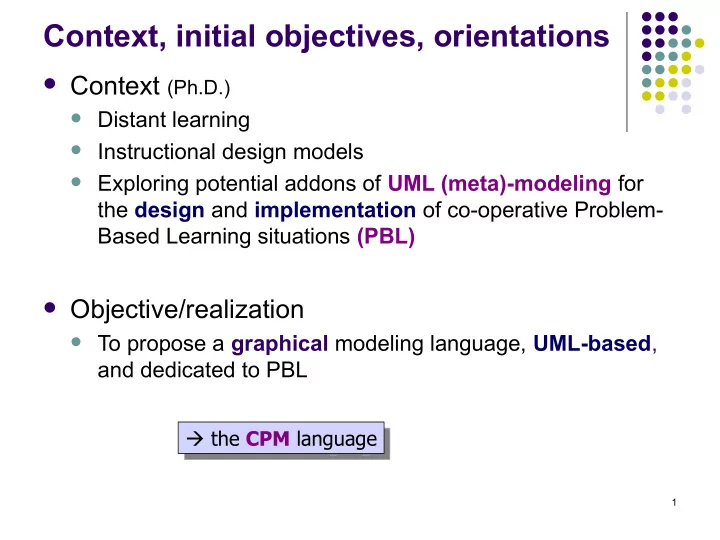

Context, initial objectives, orientations Context (Ph.D.) Distant learning Instructional design models Exploring potential addons of UML (meta)-modeling for the design and implementation of co-operative Problem- Based Learning situations (PBL) Objective/realization To propose a graphical modeling language, UML-based , and dedicated to PBL the CPM language the CPM language 1
Existent modeling languages/CPM position CPM language instructional engineers (with pre-requisite to know UML modeling bases CPM models multidisciplinary designers’ team 2
The Semantic Information Model Syntax Abstract (terminology): CPM meta-model UML-independent 35 concepts Concrete (notation): CPM profile extending UML M3 Stereotypes MOF Meta-meta-model Tagged values Preferred diagrams: conforms to M2 Meta-model UML CPM Class, Use case, meta-model Activity, States specializes Semantics conforms to CPM profile Natural language M1 and OCL rules CPM models Model M0 Real word, run-time instances 3
Experimentation, Use Cases Exploring expressiveness thanks to the SMASH case-study Detailed analysis of: Scenario specification: Definition of: Detailed analysis of: Scenario specification: Definition of: • Roles, resources • Objectives • Roles • Roles, resources • Objectives • Roles • Individual activities • Task • Resources • Individual activities • Task • Resources • Activities • Collaborative activities • Success criteria • Activities • Collaborative activities • Success criteria • Knowledge • Cooperation • Obstacle • Knowledge • Cooperation • Obstacle •… • Event management • Preliminary roles •… • Event management • Preliminary roles •… •… •… •… Uses Uses Model = set of views View = set of diagrams Uses Initial Analysis Design 4 requirements
Experimentation (2): just one example :Investigators :PoliceChief :Session manager {roleKind(learner)} {roleKind(tutor)} {roleKind(tutor)} :LearnersProductions :Corrections <<RoleParameter>> <<CollaborationMode>> {Listener} <<RoleParameter>> {les élèves écoutent la {Presenter} présentation de la scène} Planning for future presentations order Listen Scene briefing :Presentation order 5
Dedicated CASE-Tool CPM profile integrated as a module for the Objecteering UML CASE-tool Customized and adapted HMI New end-users functions Authoring environment Authoring environment prototype for prototype for instructional designers instructional designers 6
Binding facility Experimentation of models transformation Why? To extend CPM language uses To provide CPM models with an ODL platform- implementation facility How? CPM activity diagrams modeling learning scenarios Stereotypes and tagged values (extension elements from CPM profile) inform and guide transformations XML models conform to IMS-LD spec 7
Binding facility (2): simple example Element information: - Stereotype <<Role>> - Tagged Value RoleKind= learner Element information: - Stereotype <<Activity>> - Nested in a partition of learner 8
Comparison between CPM and IMS-LD CPM IMS-LD Interoperability, reuse, Main goals Communication, abstraction exchange Kind Semi-formal (graphical) Formal Language Terminology CPM meta-model IMS-LD information model Notation UML Profile CPM none Instructional engineer Instructional engineer Target audience knowing bases of UML trained to IMS-LD Initial requirements, analysis Concerned steps Detailed design and design instances Models/ Type UML models XML Models Multidisciplinary staff in Target audience Machine charge of design process Tools One prototype Several prototypes 9
Conclusion CPM Language UML-based EML Dedicated to PBL Binding facility CPM IMS-LD language language CPM CPM CPM IMS-LD models models models models Initial Detailed Design Analysis requirements design Implementation Deployment Test Evaluation Design phase 10
Positive/negative points of this UML approach for EML Graphical language Models address multidisciplinary design team Upstream IMS-LD Lack of methodological Object-based approach UML methods/techniques UML notation extension is limited /tools could be exploited Explicit modeling of Instructional engineers’ pre- information thanks to requisite to be “UML-aware” stereotype & tagged values Roles of UML Profiles in the Difficulty to create specific MDA framework tools from scratch 11
Perspectives To improve models transformation: taking into account … …other CPM diagrams from CPM models of LD …IMS-LD levels B & C IMS-LD point-of-view: Benefits of a UML-profile dedicated to IMS-LD ? Benefits of a UML-based authoring-tool for IMS-LD ? 12
Recommend
More recommend